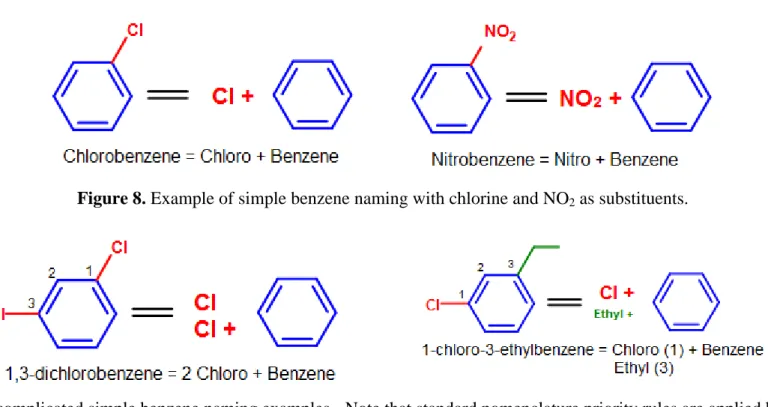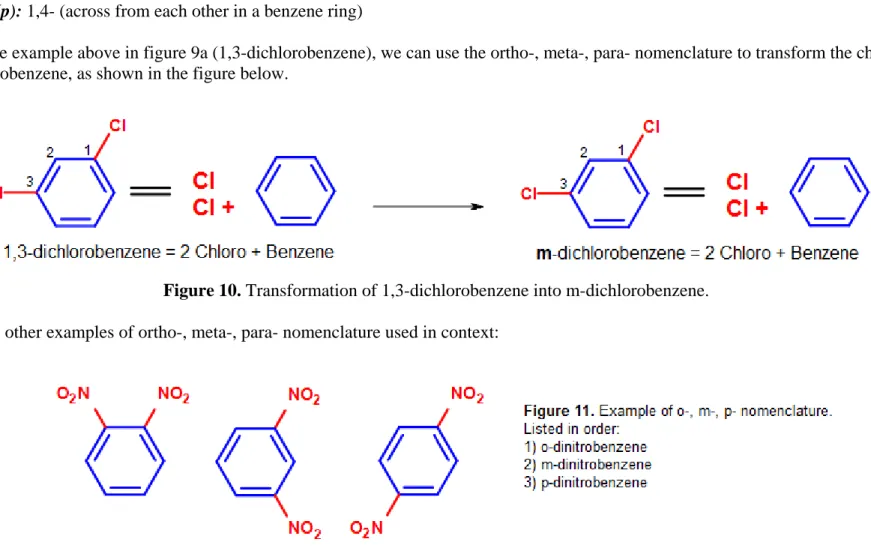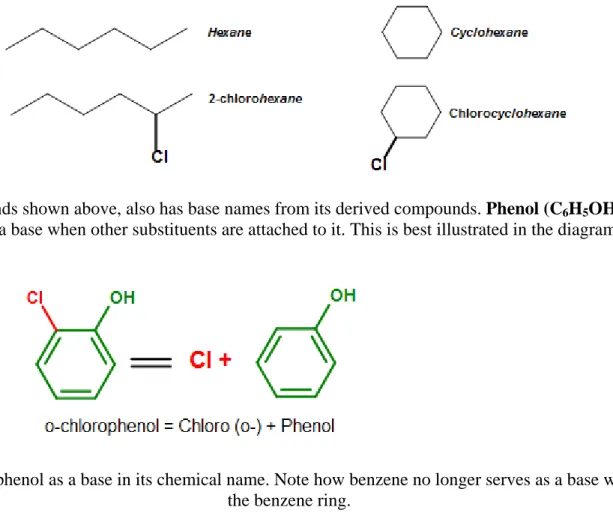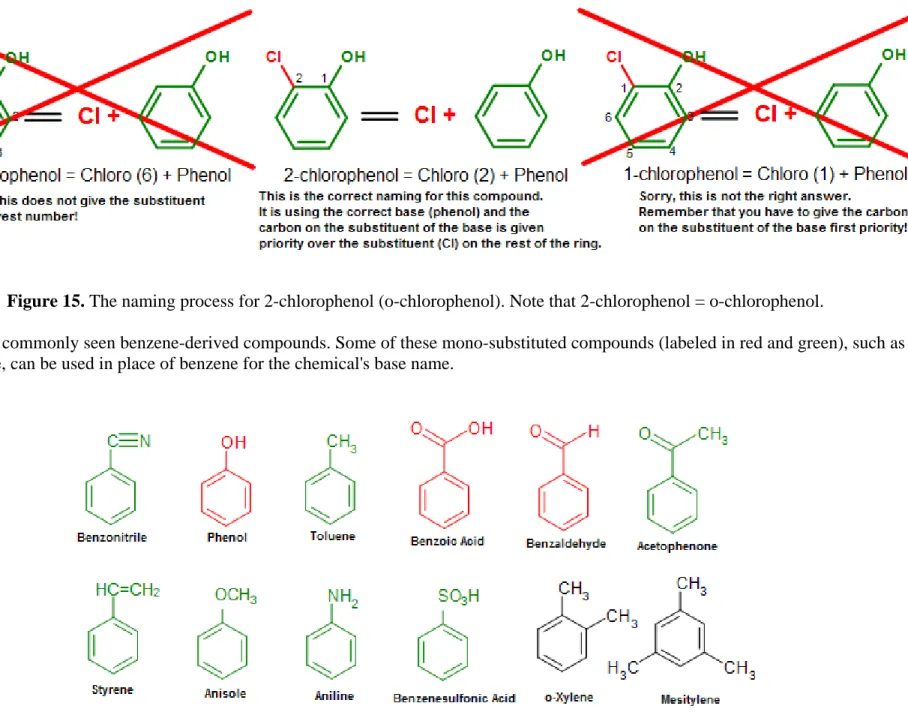BENZENE NAMING EXPLAINED. This was excerpted from CHEM WIKI and is used with appreciation to the authors. http://chemwiki.ucdavis.edu/Organic_Chemistry/Hydrocarbons/Aromatics/Naming_the_Benzenes.
Simple Benzene Naming
Some common substituents, like NO2, Br, and Cl, can be named this way when it is attached to a phenyl group. Long chain carbons attached can also
be named this way. The general format for this kind of naming is: (positions of substituents (if >1)- + # (di, tri, ...) + substituent)n + benzene.
For example, chlorine (Cl) attached to a phenyl group would be named chlorobenzene (chloro + benzene). Since there is only one substituent on the benzene ring, we do not have to indicate its position on the benzene ring (as it can freely rotate around and you would end up getting the same compound.)
Figure 8. Example of simple benzene naming with chlorine and NO2 as substituents.
Figure 9. More complicated simple benzene naming examples - Note that standard nomenclature priority rules are applied here, causing the numbering of carbons to switch.
See Nomenclature of Organic Compounds for a review on naming and priority rules.
Ortho-, Meta-, Para- (OMP) Nomenclature for Disubstituted Benzenes
Instead of using numbers to indicate substituents on a benzene ring, ortho- (o-), meta- (m-), or para (p-) can be used in place of positional markers when there are two substituents on the benzene ring (disubstituted benzenes). They are defined as the following:
• ortho- (o-): 1,2- (next to each other in a benzene ring)
• meta- (m): 1,3- (separated by one carbon in a benzene ring)
• para- (p): 1,4- (across from each other in a benzene ring)
Using the same example above in figure 9a (1,3-dichlorobenzene), we can use the ortho-, meta-, para- nomenclature to transform the chemical name into m-dichlorobenzene, as shown in the figure below.
Here are some other examples of ortho-, meta-, para- nomenclature used in context:
However, the substituents used in ortho-, meta-, para- nomenclature do not have to be the same. For example, we can use chlorine and a nitro group as substituents in the benzene ring.
Base Name Nomenclature
In addition to simple benzene naming and OMP nomenclature, benzene derived compounds are also sometimes used as bases. The concept of a base is similar to the nomenclature of aliphatic and cyclic compounds, where the parent for the organic compound is used as a base
(a name for its chemical name. For example, the following compounds have the base names hexane and cyclohexane, respectively.
See Nomenclature of Organic Compounds for a review on naming organic compounds.
Benzene, similar to these compounds shown above, also has base names from its derived compounds. Phenol (C6H5OH), as introduced previously in this article, for example, serves as a base when other substituents are attached to it. This is best illustrated in the diagram below.
Figure 14. An example showing phenol as a base in its chemical name. Note how benzene no longer serves as a base when an OH group is added to the benzene ring.
Alternatively, we can use the numbering system to indicate this compound. When the numbering system is used, the carbon where the substituent is attached on the base will be given the first priority and named as carbon #1 (C1). The normal priority rules then apply in the nomenclature process (give the rest of the substituents the lowest numbering as you could).
Figure 15. The naming process for 2-chlorophenol (o-chlorophenol). Note that 2-chlorophenol = o-chlorophenol.
Below is a list of commonly seen benzene-derived compounds. Some of these mono-substituted compounds (labeled in red and green), such as phenol or toluene, can be used in place of benzene for the chemical's base name.
Common vs. Systematic (IUPAC) Nomenclature
According to the indexing preferences of the Chemical Abstracts, phenol, benzaldehyde, and benzoic acid (labeled in red in Figure 16) are some of the common names that are retained in the IUPAC (systematic) nomenclature. Other names such as toluene, styrene, naphthalene, or phenanthrene can also be seen in the IUPAC system in the same way. While the use of other common names are usually acceptable in IUPAC, their use are discouraged in the nomenclature of compounds.
Nomenclature for compounds which has such discouraged names will be named by the simple benzene naming system. An example of this would include toluene derivatives like TNT. (Note that toluene by itself is retained by the IUPAC nomenclature, but its derivatives, which contains additional substituents on the benzene ring, might be excluded from the convention). For this reason, the common chemical name 2,4,6-trinitrotoluene, or TNT, as shown in figure 17, would not be advisable under the IUPAC (systematic) nomenclature.
In order to correctly name TNT under the IUPAC system, the simple benzene naming system should be used:
Figure 18. Systematic (IUPAC) name of 2,4,6-trinitrotoluene (common name), or TNT.
Figure 19. The common name 2,4-dibromophenol, is shared by the IUPAC systematic nomenclature. Only substituents phenol, benzoic acid, and benzaldehyde share this commonality.
Since the IUPAC nomenclature primarily rely on the simple benzene naming system for the nomenclature of different benzene derived compounds, the OMP (ortho-, meta-, para-) system is not accepted in the IUPAC nomenclature. For this reason, the OMP system will yield common names that can be converted to systematic names by using the same method as above. For example, o-Xylene from the OMP system can be named 1,2-dimethylbenzene by using simple benzene naming (IUPAC standard).
The Phenyl and Benzyl Groups The Phenyl Group
As mentioned previously, the phenyl group (Ph-R, C6H5-R) can be formed by removing a hydrogen from benzene and attaching a substituent to where the hydrogen was removed. To this phenomenon, we can name compounds formed this way by applying this rule: (phenyl + substituent). For example, a chlorine attached in this manner would be named phenyl chloride, and a bromine attached in this manner would be named phenyl bromide. (See below diagram)
While compounds like these are usually named by simple benzene type naming (chlorobenzene and bromobenzene), the phenyl group naming is usually applied to benzene rings where a substituent with six or more carbons is attached, such as in the diagram below.
Figure 21. Diagram of 2-phenyloctane.
Although the diagram above might be a little daunting to understand at first, it is not as difficult as it seems after careful analysis of the structure is made. By looking for the longest chain in the compound, it should be clear that the longest chain is eight (8) carbons long (octane, as shown in green) and that a benzene ring is attached to the second position of this longest chain (labeled in red). As this rule suggests that the benzene ring will act as a function group (a substituent) whenever a substituent of more than six (6) carbons is attached to it, the name "benzene" is changed to phenyl and is used the same way as any other substituents, such as methyl, ethyl, or bromo. Putting it all together, the name can be derived as: 2-phenyloctane (phenyl is attached at the second position of the longest carbon chain, octane).
The Benzyl Group
The benzyl group (abbv. Bn), similar to the phenyl group, is formed by manipulating the benzene ring. In the case of the benzyl group, it is formed by taking the phenyl group and adding a CH2 group to where the hydrogen was removed. Its molecular fragment can be written as C6H5CH2-R, PhCH2-R, or Bn-R. Nomenclature of benzyl group based compounds are very similar to the phenyl group compounds. For example, a chlorine attached to a benzyl group would simply be called benzyl chloride, whereas an OH group attached to a benzyl group would simply be called benzyl alcohol.
Similar to the base name nomenclature system, the carbon in which the base substituent is attached on the benzene ring is given the first priority and the rest of the substituents are given the lowest number order possible. Under this consideration, the above compound can be named:
2,4-difluorobenzyl chloride.
Additionally, other substituents can attach on the benzene ring in the presence of the benzyl group. An example of this can be seen in the figure below:
Commonly Named Benzene Compounds Nomenclature Summary Flowchart
Summary Flowchart (Figure 24). Summary of nomenclature rules used in commonly benzene derived compounds. As benzene derived compounds can be extremely complex, only compounds covered in this article and other commonly named compounds can be named using this flowchart.
Determination of Common and Systematic Names using Flowchart
To demonstrate how this flowchart can be used to name TNT in its common and systematic (IUPAC) name, a replica of the flowchart with the appropriate flow paths are shown below:



